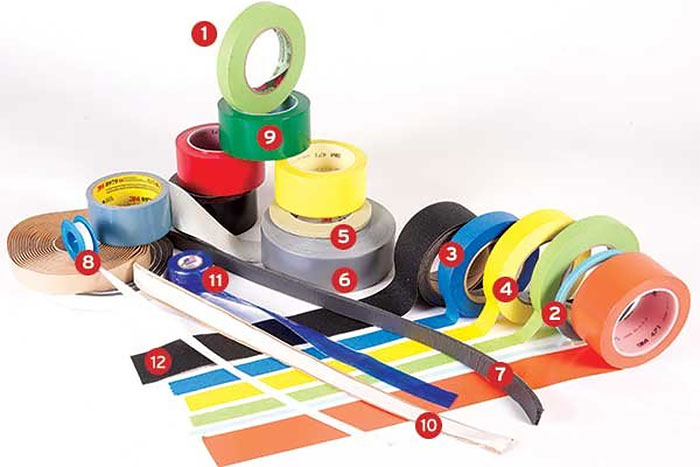Advertisement
There are literally thousands of different types of tape. We give you the skinny on which ones are the most useful aboard.

Are we really using the right tape for, the right application on our boats? I'm not the only one who's left the wrong type of tape on too long, only to spend hours trying to remove a sticky residue long after the tape itself has been peeled back and thrown out. Here, we've whittled hundreds of available tapes down to those most likely to be of use to the average boater. Buying the right tape now could save you big in the long run.
Perhaps the greatest need for tape on a boat is for masking purposes. Whether refinishing brightwork, painting on a boot stripe, or masking off for a clean edge prior to applying anti-fouling, these and more are all jobs that require proper masking. Masking tapes offer three distinct advantages; first, when correctly done, it gives a nice sharp edge to the paint; second, it prevents paint or varnish from damaging or marking adjacent surfaces, such as gelcoat; and third, it actually speeds up the work as no tedious "cutting in" with a paint brush is required.
When I built my first boat, I had little boatbuilding experience and even less money, so I bought the cheapest masking tape that I could find. The paint bled underneath, leaving unsightly paint lines, and even after just a few days, some of the tape pulled off easily while other sections clung with a tenacious grip that seemed to defy all efforts to remove it.
I've since learned the hard way that not all tape is created equal and it's a case of pay now or pay later. Here, in my experience, are some of the most useful and popular choices amongst boaters.
1. Performance Green Masking. A step up in performance and cost, green masking tape is highly conformable, so it suits many of the curves and shapes found on boats. The ideal solution for masking off areas to be varnished, as it will not come detached if it gets damp while wet sanding the adjacent area. Removes cleanly without leaving a gummy residue.
2. Fineline Masking. This thin blue masking tape is better at bending around corners than a wider tape. Gives a razor sharp edge to paint lines.
3. Blue Painter's. If you only ever use one tape for masking off when applying paint and varnish, then this should be it. Can be left in place for a week or more even outdoors and removes cleanly. This is a far better tape than the white type — which we hate so much that we have not included it in the photo.
Advertisement
4. Yellow Masking. Stronger yet than the green tape. Designed for the automotive refinishing trades, yellow will stand up to baking temperatures — cars are baked at a high temperatures after respraying. Yellow tape also stands up well if used for masking off areas to be wet sanded. Conforms well to curves.
5. Scotch Fineline. If you ever have to recaulk the joints on a teak deck using a polysulphide-type seam compound, this tape is perfect as a bond breaker that is used at the bottom of the seam before caulking is applied.
6. Duct Tape. Gets its name from its use as a sealer for A/C ducts, but there can be few that have not succumbed to its charms. Perfect for all sorts of semi-permanent jobs aboard, but is broken down by UV, so best left for uses belowdecks out of the sunlight. For longer lasting jobs, there's now "performance" duct tape (Gorilla Tape), stronger than the original with an even more tenacious bond. I can attest to its strength as I sailed across the Atlantic with a toilet held in place with duct tape.
7. Neoprene Foam. The perfect solution for cushioning hatch covers, and silencing squeaky sole boards.
8. Thread Sealing. Often called Teflon tape, thread-sealing tape is used for sealing threads on plumbing fittings — although never for propane, which requires a different type of tape.
8. Vinyl. Often called electrician's tape, vinyl tape is often the go-to tape for semi-permanent jobs. Providing the substrate is clean and dry, vinyl tape adheres to almost any surface. If you only have one type of tape in your toolkit, then this should be it. Make temporary repairs to wiring, cover rigging connections, whip the ends of ropes, and thousands of other uses. Comes in tons of bright colors.
9. Butyl. More a sealing compound in a roll rather than a tape in the traditional sense, butyl makes a great choice for bonding hardware as it never hardens and remains flexible. Best applied in warm weather, as it tends to stiffen noticeably in cooler temperatures.
10. Rescue. A modern take on older self-amalgamating tapes. Sticks to itself, plus it's heat resistant and waterproof — the perfect solution for temporarily sealing leaks in hoses and pipework.
11. Non-Skid. Steps and varnished decks can be slippery when wet. A few strategically placed strips of non-skid tape are the perfect answer to preventing accidents.
